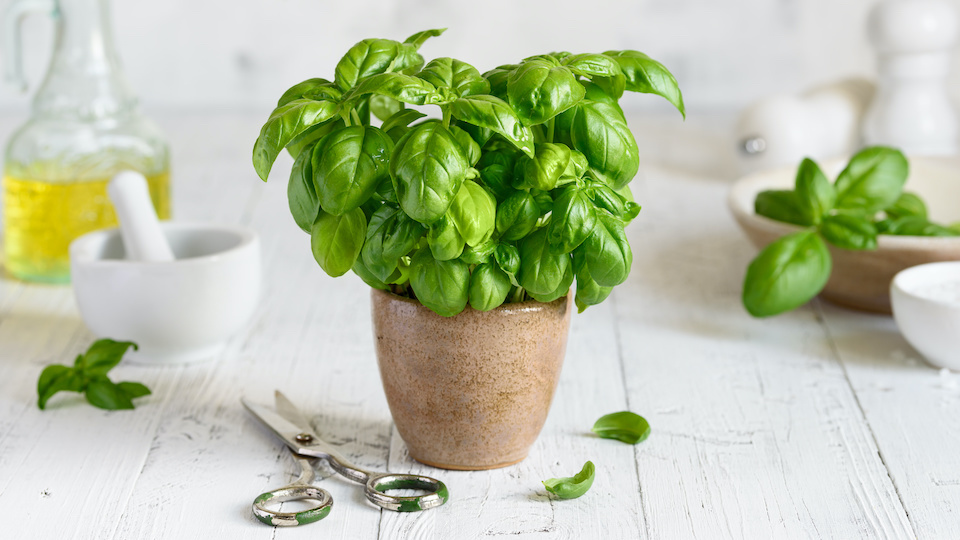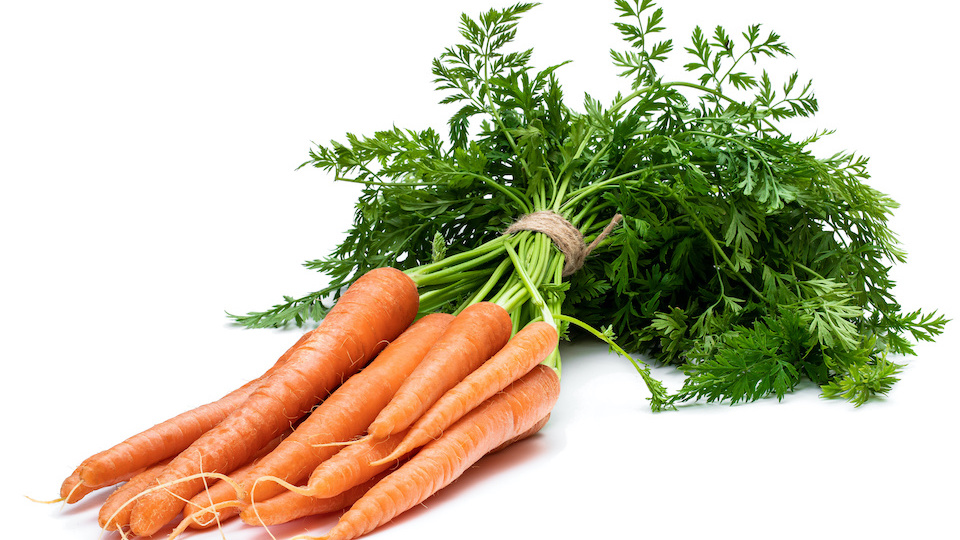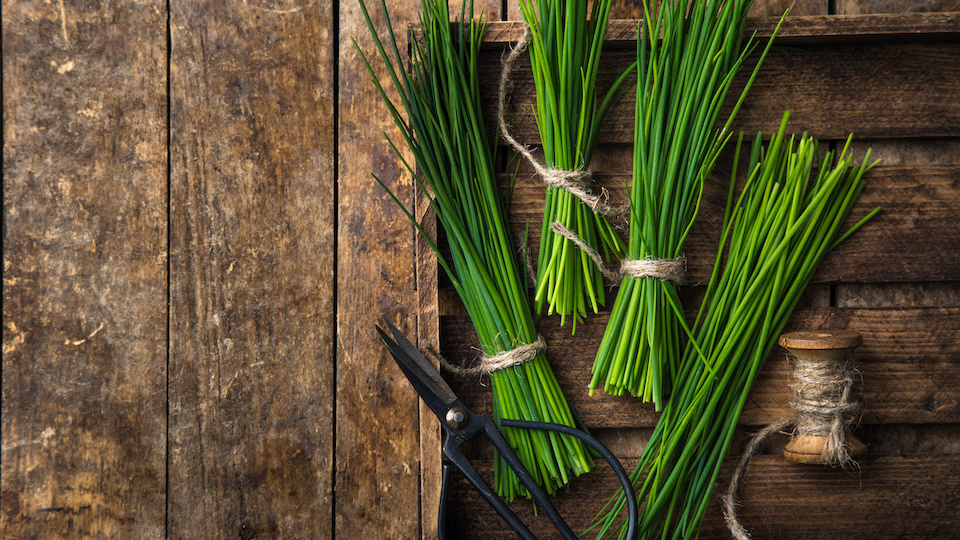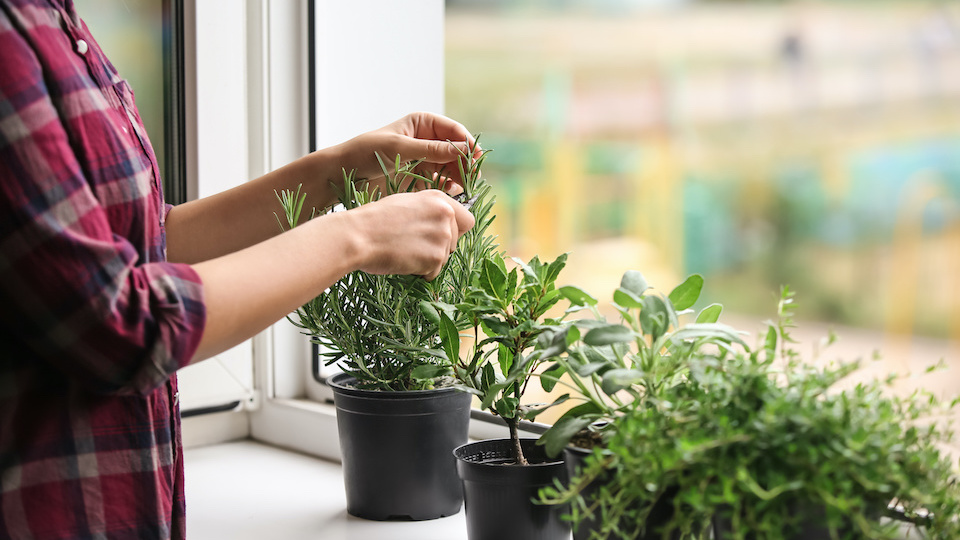You don’t have to be a gardening mastermind to grow your own edible plants; you don’t even have to have space outside for a garden! In fact, there are lots of health-promoting plants that can be grown indoors, even in a tiny apartment space. Just imagine, all you have to do is wake up in the morning and take a few steps to tend your crops.
To start your garden inside, you need to consider the same elements that you’d think about when growing outdoors: sun, soil, and water. We’ll start with sunlight since that can be the most challenging. Every plant has specific needs when it comes to the sun. If it requires full sun, you’ll need to place the plant in a spot like a windowsill, where it will get direct sun for six hours a day. Partial sun means that it needs a few hours of sunlight in the morning or afternoon. Plants that need full shade are the easiest to maintain indoors, as they can be placed just about anywhere other than a room that’s dark all day.
Soil is easy. Just head to your local nursery, garden, or home store and purchase lightweight, bagged potting soil. I always look for potting soil that’s safe for organic gardening with high-quality ingredients, and of course, no chemicals. Good soil offers a balanced level of vitamins and nutrients that seeds need to thrive, grow large, and taste delicious. While water preferences can vary from plant to plant, for plants that are deep-potted, use a watering can that provides a “rain shower.” For smaller pots or crops, a spray bottle generally works well to provide the moisture that plants need.
Avocados

Avocados are filled with healthy fats, and they are high in vitamin A in the form of carotenoids, which are known to lower the risk of heart disease, cancer, and vision problems. They also contain lots of vitamin E and vitamin B6.
You can actually grow new avocados from a used avocado, but it can be challenging and doesn’t always produce edible fruit. For a greater chance of success, buy a dwarf avocado plant. Place some sand at the bottom of a large, well-draining pot and then plant your tree. Water it regularly, but don’t let it become waterlogged. As dwarf trees can grow to be very tall, higher than ten feet, it’s best to grow it in a room with high ceilings.
If you have the green variety, the fruit will be ready for harvest when the skin turns slightly yellow. Darker varieties are ready when the skins turn almost black. Don’t let ripe fruit stay on the tree for longer than a few weeks, or it will begin to lose its texture and flavor.
Basil

Basil is popular for culinary use, frequently used to flavor meats, stews, and sauces. Plus, it offers lots of medicinal benefits thanks to its analgesic, anti-inflammatory, and antioxidant properties.
Basil can be grown indoors by planting seeds or a starter in one of the smaller, globe-type containers. Avoid the larger types, or you’ll end up with space issues. It should be at least four inches wide, however, and contain good drainage holes too. These plants need lots of sun and warm temperatures and should have their soil fertilized once a month. They also need plenty of water. Water every other day, or if it’s very hot, once a day. Check the soil; if it’s dry, it needs water. Start to prune when the top leaves of the plant reach about six inches in height. Continue to prune as it gets bushier, pinching off any flowers that appear.
To harvest, gently snip a few leaves off, being careful not to remove all leaves from any one plant.
Carrots

Carrots are famous for their ability to protect eye health, as they’re rich in beta-carotene. This has been shown to help reduce the risk of developing macular degeneration and cataracts. Carrots also contain many vitamins and minerals, including folate, potassium, manganese, niacin, thiamin, and vitamins A, B6, C, and K.
Like most root vegetables, carrots make a great addition to a window box, though it needs to be at least 18 inches deep and wide, with drainage holes at the bottom. Fill your container to within an inch of the top, using a potting mix that contains lots of humus. Water the soil before planting seeds an inch apart in rows that are six inches apart from each other. Press the seeds gently, then cover with a thin layer of soil. They need to be in an area that gets lots of sun, like your windowsill, and they require moist, but not soaked soil. You may want to soak some peat moss in water overnight and then spread that on top of the seeds to preserve moisture.
When your carrots have grown to above 3/4 of an inch across the top, just below the stem, they’re ready for harvest. If you don’t see the actual carrot, you can brush some of the soil around the stem. Don’t wait too long, as the bigger they get, the more they start to lose their flavor. Pick them by grabbing firmly at the root and wiggling them around before pulling straight up. If your soil is too hard, water it and then wait for an hour before trying again.
Chives

Chives contain a good amount of vitamin K and are especially rich in vitamin A, with 145 percent of the daily recommended value in a half-cup. They also contain carotenes, the flavonoids that help protect you from mouth and lung cancer, and offer anti-inflammatory, antibiotic, antibacterial, antiviral, antifungal, and antimicrobial properties, too.
Select a pot that’s six to eight inches in diameter. Fill it nearly to the top with organic potting soil. Plant your seeds and cover them with a light layer of soil. Place the container in a spot that gets partial shade and then water it regularly, checking the soil often to make sure it never dries out.
Snip the leaves gently from each plant. Don’t remove all the leaves from any one plant.
Garlic greens

Garlic is one of the healthiest things you can consume. It’s a superfood that contains cancer-fighting properties. It has also been associated with a lowered risk of heart disease, reduced high blood pressure, and lowered cholesterol.
Growing garlic bulbs indoors can be challenging. Thankfully, garlic greens are much easier to grow and can be used just like scallions. Purchase a few garlic bulbs with small cloves and use a four-inch pot with drainage holes at the bottom. Fill the pot with potting soil to about a half-inch below the top. Break the bulbs into individual cloves, leaving the peel on, and then push each one about an inch into the soil, with the pointy end up, planting 12 coves close together. Place the pot in a sunny area and water well. Keep the soil moist but not soggy. You should start to see green shoots in a week or so.
When the shoots have reached eight to ten inches tall, clip what you need using scissors. When the cloves start putting out more sprouts, compost the contents of your pot and fill it up again with new potting soil. Plant new cloves and know that each one only sprouts good greens once, so you’ll have to continuously re-plant.
To your garden and your health!
-Susan Patterson



